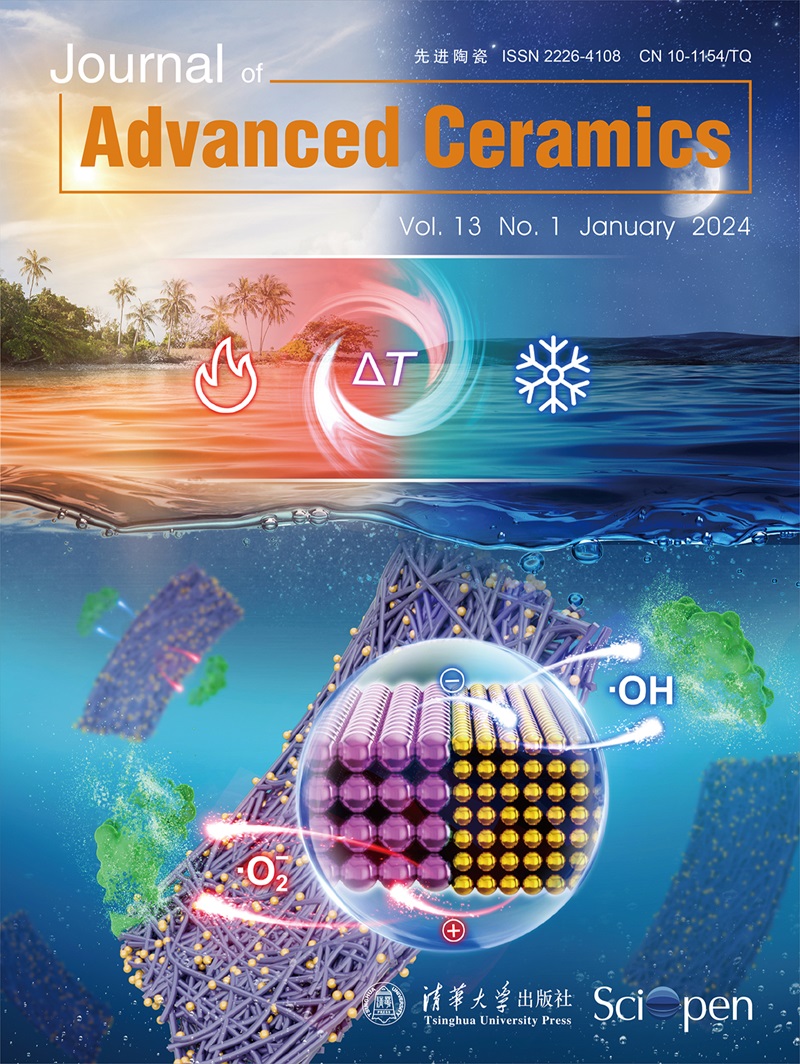单源前驱体衍生的高熵金属碳化物纳米线:微观结构和生长演化
IF 16.6
1区 材料科学
Q1 MATERIALS SCIENCE, CERAMICS
引用次数: 0
摘要
近年来,高熵金属碳化物(hec)由于其特殊的物理和化学性质引起了人们的广泛关注。块状hec陶瓷的优异性能和独特的几何特性为一维hec作为一种具有独特发展潜力的新型材料的出现铺平了道路。本文成功制备了一种新型的(Ti0.2Zr0.2Hf0.2Nb0.2Ta0.2)C纳米线。在合成纳米线之前,分析了含(Ti, Zr, Hf, Nb, Ta)前驱体(PHECs)的组成和微观结构,发现二乙烯基苯(DVB)加速了前驱体的转化过程,促进了hec的形成,也为纳米线的生长提供了部分碳源。此外,通过调整PHECs与DVB的比例,合成了多支、单支和单支弯曲纳米线。所得的单支(Ti0.2Zr0.2Hf0.2Nb0.2Ta0.2)C纳米线表面光滑,平均直径为130~150 nm,长度为几十微米,呈单晶结构,沿[11(_)1]方向生长。(Ti0.2Zr0.2Hf0.2Nb0.2Ta0.2)C纳米线的生长符合顶型气-液-固机制。本研究不仅成功实现了催化剂辅助聚合物热解制备HECs纳米线,而且对影响其产率和形貌的因素进行了全面分析,突出了这些有吸引力的纳米材料的潜在应用前景。本文章由计算机程序翻译,如有差异,请以英文原文为准。
Single-source precursor derived high-entropy metal-carbide nanowires: Microstructure and growth evolution
In recent years, high-entropy metal-carbides (HECs) have attracted significant attention due to their exceptional physical and chemical properties. The combination of the excellent performance exhibited by bulk HECs ceramics and the distinctive geometric characteristics has paved the way for the emergence of one-dimensional (1D) HECs as a novel material with unique development potential. Herein, we successfully fabricated a novel (Ti0.2Zr0.2Hf0.2Nb0.2Ta0.2)C nanowire derived via Fe-assisted single-sourced precursor pyrolysis. Prior to the synthesis of the nanowires, the composition and microstructure of (Ti, Zr, Hf, Nb, Ta)-containing precursor (PHECs) were analyzed, and divinylbenzene (DVB) was used to accelerate the conversion process of the precursor and contribute to the formation of HECs, which also provided partial carbon source for the nanowire growth. Additionally, multi-branched, single-branched and single-branched bending nanowires were synthesized by adjusting the ratio of PHECs to DVB. The obtained single-branched (Ti0.2Zr0.2Hf0.2Nb0.2Ta0.2)C nanowires possessed smooth surfaces with an average diameter of 130~150 nm and a length of several tens of micrometers, which were single-crystal structure and typically grew along [11(_)1] direction. And the growth of (Ti0.2Zr0.2Hf0.2Nb0.2Ta0.2)C nanowires was in agreement with top-type vapor-liquid-solid mechanism. This work not only successfully achieved the fabrication of HECs nanowires by a catalyst-assisted polymer pyrolysis, but also provided a comprehensive analysis of the factors affecting their yield and morphology, highlighting the potential application of these attractive nano-materials.
求助全文
通过发布文献求助,成功后即可免费获取论文全文。
去求助
来源期刊

Journal of Advanced Ceramics
MATERIALS SCIENCE, CERAMICS-
CiteScore
21.00
自引率
10.70%
发文量
290
审稿时长
14 days
期刊介绍:
Journal of Advanced Ceramics is a single-blind peer-reviewed, open access international journal published on behalf of the State Key Laboratory of New Ceramics and Fine Processing (Tsinghua University, China) and the Advanced Ceramics Division of the Chinese Ceramic Society.
Journal of Advanced Ceramics provides a forum for publishing original research papers, rapid communications, and commissioned reviews relating to advanced ceramic materials in the forms of particulates, dense or porous bodies, thin/thick films or coatings and laminated, graded and composite structures.
 求助内容:
求助内容: 应助结果提醒方式:
应助结果提醒方式:


